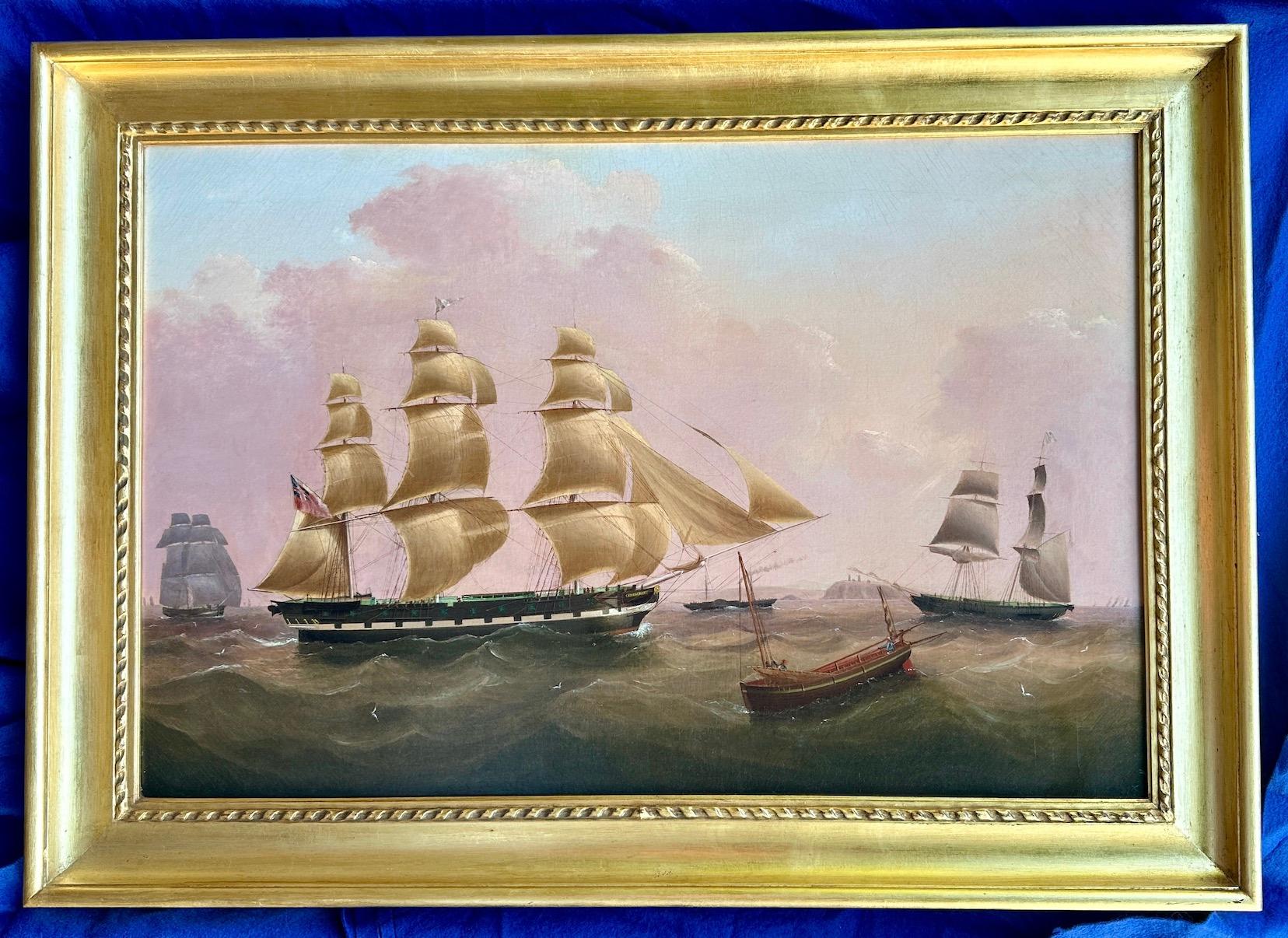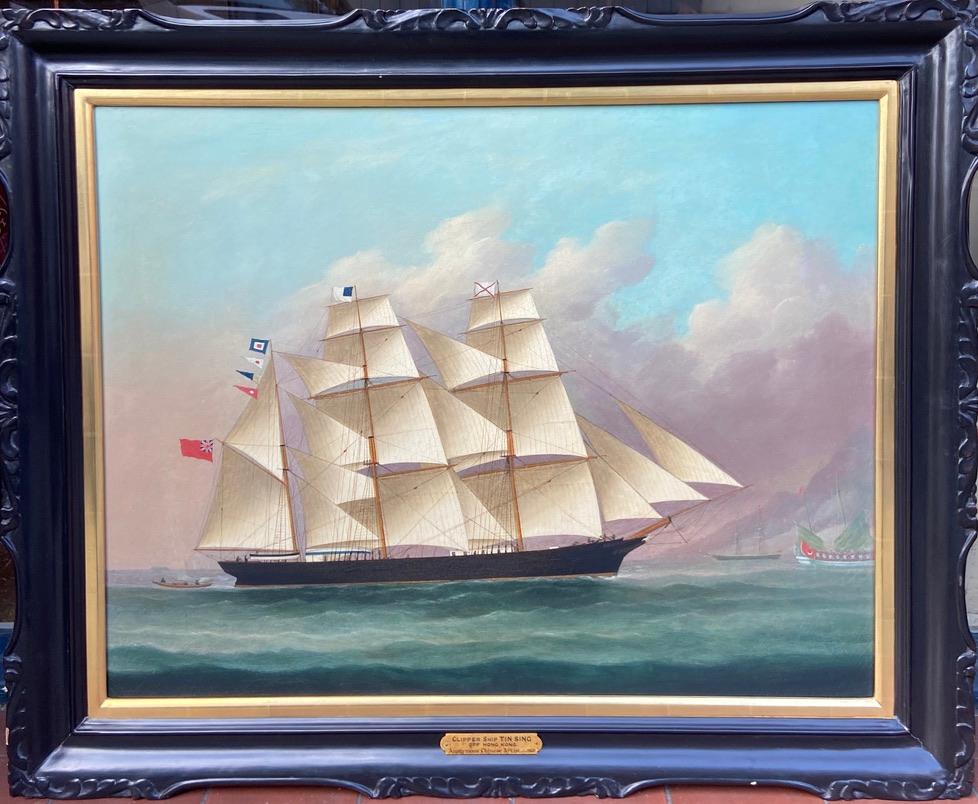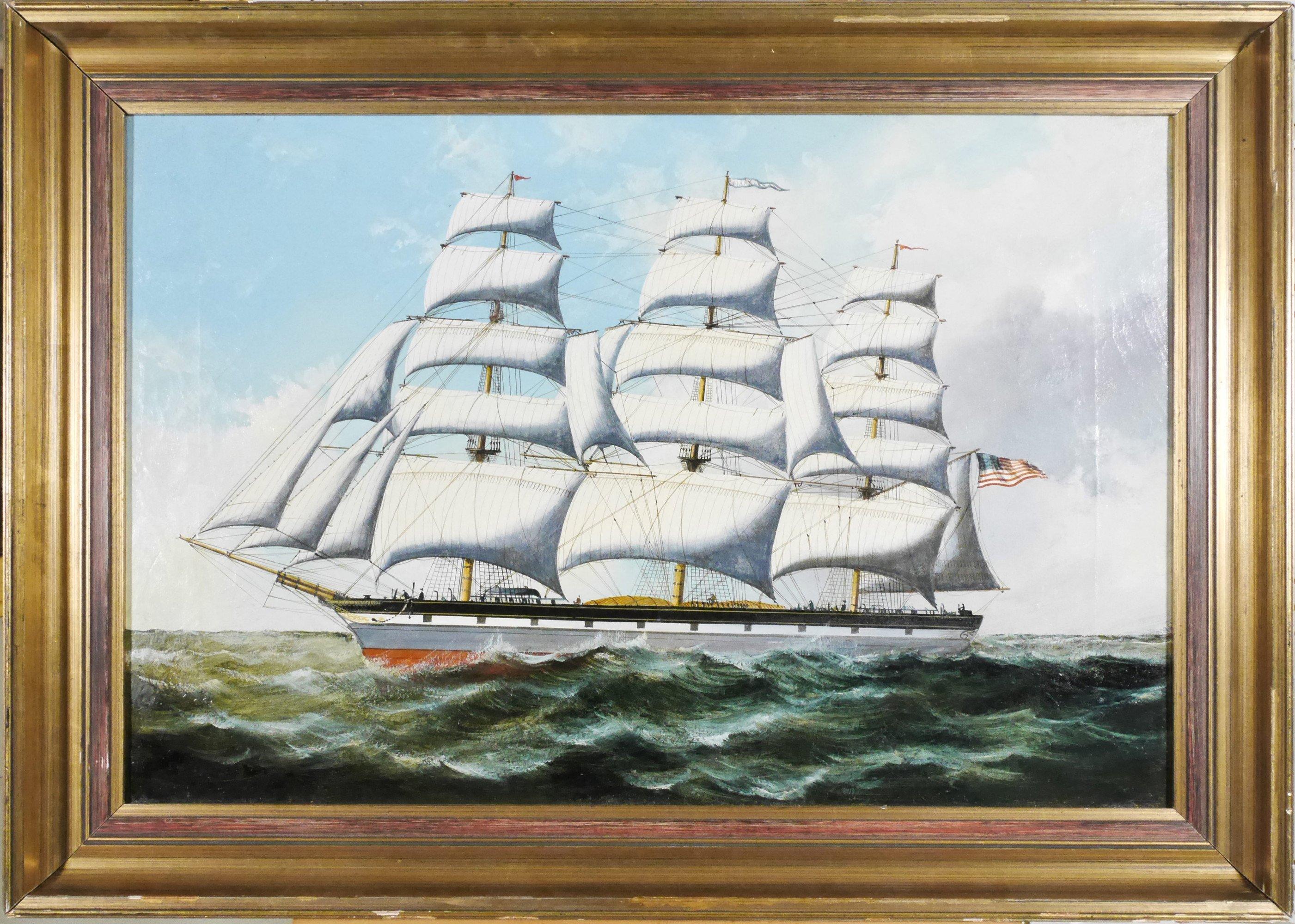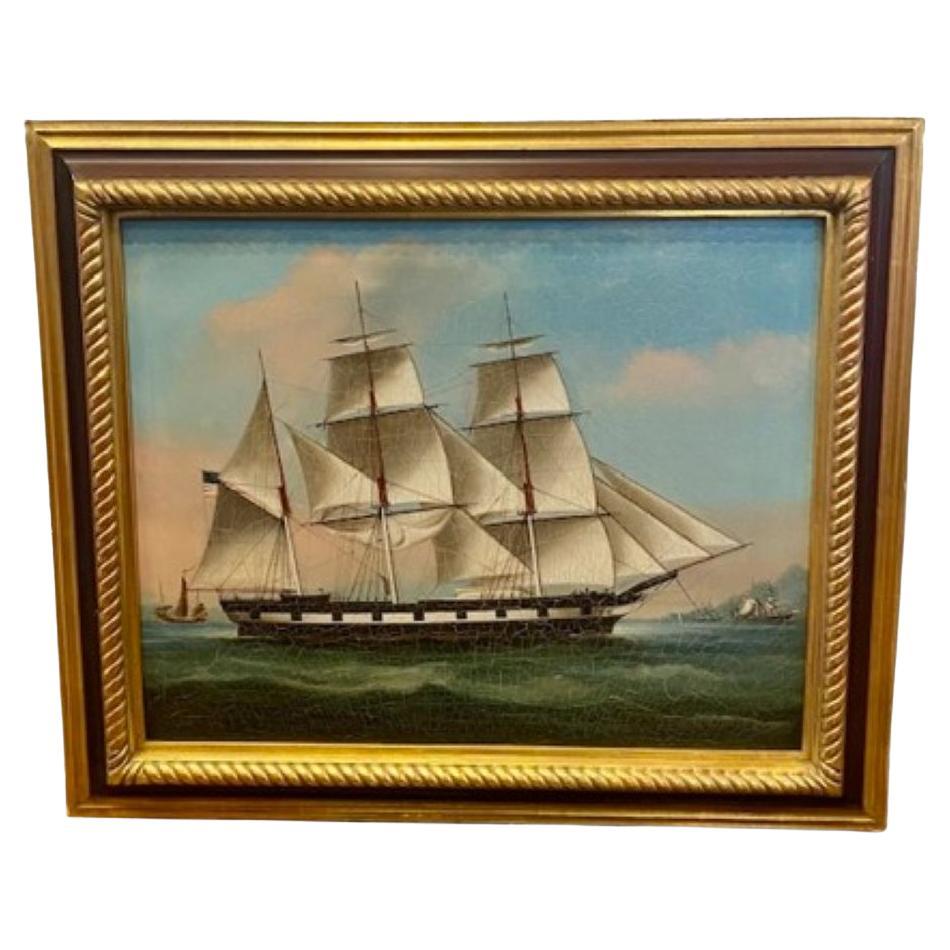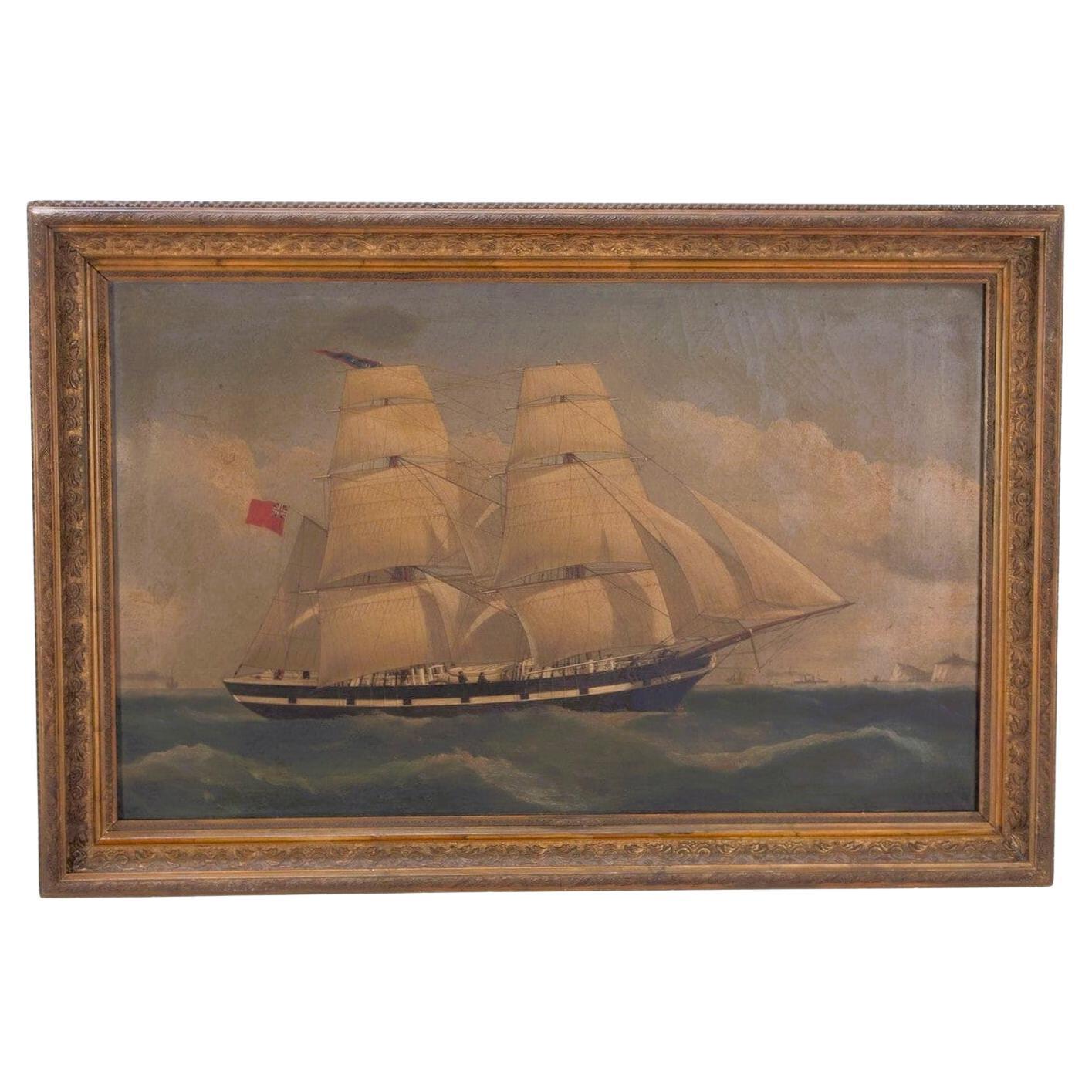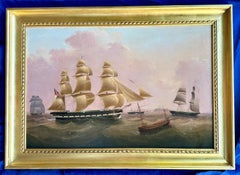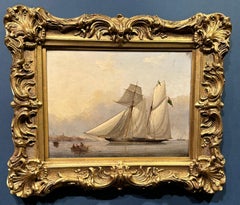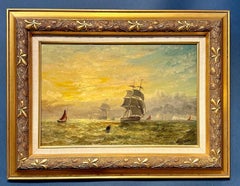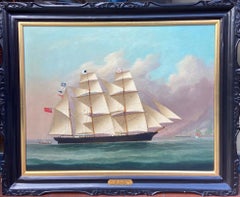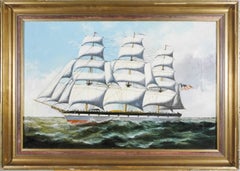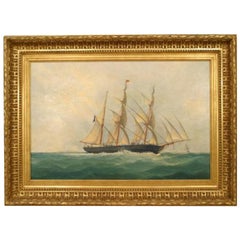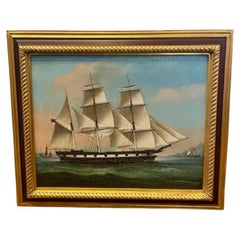Items Similar to 19th century Ship portrait of the
Video Loading
Want more images or videos?
Request additional images or videos from the seller
1 of 16
Joseph Heard19th century Ship portrait of thecirca 1840
circa 1840
$5,790
£4,353.68
€5,034.20
CA$8,171.29
A$8,866.26
CHF 4,703.39
MX$108,876.97
NOK 58,165.60
SEK 55,082.75
DKK 37,578.20
About the Item
The former Curator of Oil Paintings at the National Maritime Museum, E H H Archibald, says of Joseph Heard in his Dictionary of Sea Painters in Europe and America that "…with Samuel Walters he must stand as the top-ranking Liverpool ship portraitist of the 19th century." He would have known the artist's work well as the National Maritime Museum has eleven paintings by Heard in its collection.
Joseph Heard was born on 7th March 1799 in Egremont near Whitehaven in Cumberland. His father, also Joseph, was a saddler and it is believed that the aspirant painter received some artistic training from John Clementson who was a local portrait painter. Joseph had a brother Isaac who painted portraits. It is possible that Joseph came across the work of H Collins who was a ship portraitist from the area as well as the important marine painter Robert Salmon who was from Whitehaven also.
However, little is known of his background apart from that he went to London in the mid 1820s but his stay was brief for he exhibited a portrait in a Whitehaven in 1826 and then at the Carlisle Academy in 1827. His professional career started in Whitehaven until he moved to Liverpool in 1834 together with his brother and they shared a studio, Joseph working on marines and Isaac on human portraits. It was there that he established himself as an eminent portrayer of the ships that plied their trade through Britain's second most important Empire port. There were many wealthy ship owners and captains eager to have their prized vessels portrayed on canvas and not necessarily off the coast of Liverpool.
He was a fine exponent of this genre of painting, with well observed and beautifully painted waves which are bright and lively. His knowledge of the ships depicted is plain to see and they are nearly always off a headland, lighthouse or port. He would have known well the coasts around Liverpool and its environs but the more distant and foreign topography would, as was common with marine painters at that time, probably have been based on prints or other paintings.
Heard's work has sometimes been confused with that of his fellow Liverpool marine artists, D MacFarlane and Samuel Walters but, as Archibald points out, "…he usually has a couple of idiosyncracies: a little curved bow wave, and a steamer usually somewhere appearing in the background of his paintings".
He remained in Liverpool for the rest of his life, and died in Upper Pitt Street on 17th November, 1859 at the age of 60. The Merseyside Maritime Museum, with nine examples, holds the largest collection of Heard's paintings apart from the National Maritime Museum. Other collections where his work can be seen include: Beacon Museum, Whitehaven; Walker Art Gallery, Liverpool; University of Liverpool; National Museum of Ireland; North Devon Maritime Museum; Tulic House Museum; Helena Thompson Museum; Snowshill Manor (National Trust); Peabody Museum of Salem in America. Some examples of titles include: "The Ship 'Sir Walter Scott' in New York", "The Clipper 'Star of the East' in Australia", "The Barque 'Charles Eyes', Captain Moss, off an Iceberg", "The Paddle Steamer 'Countess of Lonsdale'", The Port of Liverpool; in the foreground, the Ship ' John Campbell' owner Isaac Bold" and "The Barque Huguenot in a Gale."
Dictionary of Sea Painters – E H H Archibald
The Dictionary of British Marine Painters - Arnold Wilson
The Dictionary of Victorian Painters - Christopher Wood
Marine Painting - Denys Brook-Hart
The word barque (sometimes barc or bark) comes from a long etymological line with some claiming that it originated with the Greek word baris which referred to a type of Egyptian boat. It then appears in the Latin barca but this word in turn was possibly influenced by the Celtic barc and then the word progressed into Spanish, Italian and French from where it entered into English but had duality of meaning. The Latin languages use of barca referred to a small boat whereas the French barque implied a full-size ship. Prior to the 19th century in England, a barge described a small vessel used on inland waterways or close to the coast but by the mid-1800s, a bark or barque was distinct in meaning a ship of certain rigging.
The term as we know it now refers to a three-masted sailing vessel where the fore and mainmast are square-rigged and the bow and stern are not ornamented with a carved figure. The stern was broad and full and had windows and the ships became the workhorses of maritime commerce because they were efficient and required a relatively small crew to sail them because they carried fewer large square sails. Usually this meant thirty sailors aboard but a barque could just be operated with only ten. Although not as fast as a full-rigged vessel, a barque was easier to handle and had a significant advantage in being better at going to windward and this versatility was ideal for its commercial use.
This example is not signed , but the ships name is seen on the front of the ship..!
Framed in a new English hand made frame
- Creator:Joseph Heard (1799 - 1859, British)
- Creation Year:circa 1840
- Dimensions:Height: 32 in (81.28 cm)Width: 44 in (111.76 cm)
- Medium:
- Movement & Style:
- Period:
- Condition:The painting was relined about 30 years ago and has been lightly cleaned to return it to the original colors.
- Gallery Location:Woodbury, CT
- Reference Number:1stDibs: LU507316476712
About the Seller
5.0
Platinum Seller
Premium sellers with a 4.7+ rating and 24-hour response times
Established in 1983
1stDibs seller since 2016
511 sales on 1stDibs
Typical response time: 1 hour
- ShippingRetrieving quote...Shipping from: Reigate, United Kingdom
- Return Policy
Authenticity Guarantee
In the unlikely event there’s an issue with an item’s authenticity, contact us within 1 year for a full refund. DetailsMoney-Back Guarantee
If your item is not as described, is damaged in transit, or does not arrive, contact us within 7 days for a full refund. Details24-Hour Cancellation
You have a 24-hour grace period in which to reconsider your purchase, with no questions asked.Vetted Professional Sellers
Our world-class sellers must adhere to strict standards for service and quality, maintaining the integrity of our listings.Price-Match Guarantee
If you find that a seller listed the same item for a lower price elsewhere, we’ll match it.Trusted Global Delivery
Our best-in-class carrier network provides specialized shipping options worldwide, including custom delivery.More From This Seller
View AllEnglish 19th century portrait of the Clipper ship Crescent at sea in full sail
By John Lynn
Located in Woodbury, CT
English 19th century portrait of the Clipper ship Crescent in full sail.
Acquiring a 19th-century English portrait of a clipper ship is more than just adding a painting to your coll...
Category
1850s Victorian Portrait Paintings
Materials
Canvas, Oil
19th Century English school, Shipping in rough seas
Located in Woodbury, CT
This dramatic seascape, painted in the mid-19th century, captures the timeless struggle between man, vessel, and the unforgiving sea. The composition centers on a distressed sailing ...
Category
1880s Victorian Landscape Paintings
Materials
Canvas, Oil
19th Century English Yacht in full sail racing on the high sea
Located in Woodbury, CT
This evocative 19th-century marine scene by English painter Nicholas Matthew Condy captures the dynamic tension and atmospheric drama that typify his maritime works. Known for his ke...
Category
1840s Victorian Figurative Paintings
Materials
Oil, Board
Antique Victorian, Impressionist 19th century English oil, Fishings boat at Sea
By Adolphus Knell
Located in Woodbury, CT
Antique Victorian, Impressionist 19th century English oil, Fishings boat at Sea.
Adolphus Knell was a superb painter of marine subjects during the middle of the 19th century. His w...
Category
1860s Victorian Figurative Paintings
Materials
Oil, Board
$3,160 Sale Price
20% Off
Free Shipping
19th century English Warship at sea with the Sun rising or Setting
By Adolphus Knell
Located in Woodbury, CT
Adolphus Knell
19th-century English Warship at sea
Owning in a 19th-century English fishing boat captured at sea circa 1880 by Adolphus Knell, with the sun rising or setting, offer...
Category
1880s Victorian Landscape Paintings
Materials
Oil, Panel
19th century English marine of Dutch or English boats off a coastline
By James Webb
Located in Woodbury, CT
This James Webb English marine painting, circa 1870, is a masterpiece of atmospheric charm and technical precision that would appeal profoundly to an interior designer or fine art co...
Category
1870s Victorian Landscape Paintings
Materials
Oil, Board
You May Also Like
19th Century China Trade Painting of Clipper Ship Tin Sing off Hong Kong
Located in London, GB
Anonymous Chinese Painter
Clipper Ship Tin Sing of Hong Kong
Oil on Canvas
25 X 32 inches
Category
19th Century Landscape Paintings
Materials
Oil
Clipper Mary Lee in High Seas, mid-19th century American school ship seascape
Located in Beachwood, OH
American School, Mid-19th Century
The Clipper Mary Lee in High Seas
Oil on canvas
Unsigned
25 x 35 inches
Craquelure commensurate with age, minor losses on frame.
Category
Mid-19th Century Landscape Paintings
Materials
Oil
Copy of a Seascape Ship Painting
Located in Queens, NY
Copy of a seascape painting showing a ship in the open sea with another ship in the distance
Category
Late 20th Century American Napoleon III Paintings
Materials
Paint
19th Century China Trade Ship Portrait of the American Clipper Ship ORIENTAL
Located in Nantucket, MA
19th Century China Trade Ship Portrait of the American Clipper Ship ORIENTAL, under full sail on starboard tack leaving Hong Kong Harbor for Bost...
Category
Antique 1850s Hong Kong Chinese Export Paintings
Materials
Canvas
19th Century English Marine Oil Painting
Located in Shipston-On-Stour, GB
A nicely executed mid C19th British School oil on canvas, depicting a clipper vessel named ‘Jennie’, with other vessels and cliffs of Dover in the background, and realistic seas. Set...
Category
Antique 1850s English Country Paintings
Materials
Canvas, Giltwood, Paint
Fine 19th Century French Oil Painting - Paddle Steamer Ship Choppy Waters
Located in Cirencester, Gloucestershire
Artist/ School: 19th Century French School
Title: A Paddle Steamer in Choppy Waters, period fine quality gilt frame.
Medium: oil painting on canvas, framed
Size: canvas: 21.25” x...
Category
Mid-19th Century Victorian Landscape Paintings
Materials
Canvas, Oil
